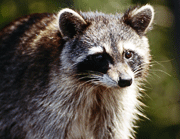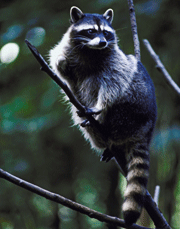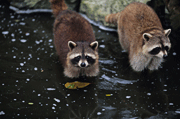Raccoons & Pools

Raccoons can be pests and can spread germs to humans. It is important to keep raccoons out of your pool and watch for raccoon feces (poop) in and around your pool. Raccoon feces can sometimes contain the eggs of a worm called Baylisascaris procyonis, which can infect humans, particularly children, and cause severe neurologic illness.
What is Baylisascaris?
Baylisascaris is a roundworm parasite that commonly infects raccoons. Raccoons infected with Baylisascaris can be found in all parts of the United States 1–13. When people are exposed to Baylisascaris eggs they can become ill.
What illness does Baylisascaris cause?
Baylisascaris infections in people are very rarely diagnosed. Swallowing a few Baylisascaris eggs can result in no or few symptoms. However, swallowing a large number of eggs can result in severe disease that affects the nervous system or eyes 14–17.
How is Baylisascaris spread?
The parasite is spread by swallowing Baylisascaris eggs, which are found in the feces of raccoons that are infected with Baylisascaris. People can be exposed to Baylisascaris eggs in soil, water, or on objects that have been contaminated with feces from an infected raccoon 14–17.
Additional information on the disease can be found on the CDC Baylisascaris Website.
What should I do if I find raccoon feces or a dead raccoon in my pool?
Although chlorine in pools will kill most germs that a raccoon could carry into the water, it does not kill Baylisascaris eggs. If raccoon feces or a dead raccoon are found in the pool:
- Close the pool to swimmers. Then
- Test the raccoon or its feces for Baylisascaris. If the feces or raccoon tests positive for Baylisascaris, clean the pool as described in the following sections.
OR - Clean the pool as described in the following sections, if you do not want to test the raccoon feces.
- Test the raccoon or its feces for Baylisascaris. If the feces or raccoon tests positive for Baylisascaris, clean the pool as described in the following sections.
How should I test raccoon feces for Baylisascaris?

- Put on disposable gloves and collect the feces or retrieve the dead raccoon. Double bag the feces or animal in plastic garbage bags. Remove gloves and place them in the garbage bags. Wash your hands thoroughly with soap and water afterwards.
- Contact Animal Control (the local government agency in charge of animal issues) or your local health department about testing raccoon feces for Baylisascaris eggs. The only way to find out if a raccoon is infected with Baylisascaris is to test the feces.
- If the lab test shows evidence of Baylisascaris eggs, then you need to clean your pool as described below. If the lab test is negative, you do not need to clean your pool as described below.
How do I clean my pool if it has been contaminated with Baylisascaris?
Because Baylisascaris eggs are particularly tough, adding chlorine to the water will not kill them. If a lab test has confirmed that the raccoon was infected with Baylisascaris or you don’t know if the raccoon was infected because the raccoon’s feces were not tested, there are two options for cleaning your pool.
*Remember to close the pool to swimmers until you have finished cleaning the pool.
Option 1:
- Filter the pool for a minimum of 24 hours and then backwash the pool filter.
- Put on disposable gloves to replace the material doing the filtering (if possible). Double bag the discarded material in plastic garbage bags. Remove gloves and place them in the garbage bags. Wash your hands thoroughly with soap and water afterwards.
Option 2:
- Backwash the pool filter.
- Drain and hose down the pool.
- Put on disposable gloves to replace the material doing the filtering (if possible). Double bag the discarded material in plastic garbage bags. Remove gloves and place them in the garbage bags. Wash your hands thoroughly with soap and water afterwards
- Refill the pool.
What can I do to keep raccoons out of my swimming pool?

Raccoons usually choose certain locations to defecate (poop) and then use those same places repeatedly. Raccoons can also be attracted to areas where humans live and play. In pools, raccoons usually defecate in the shallow areas (for example, on the steps).
Here are some tips for keeping raccoons out of your pool:
- Cover the pool area that has been visited by raccoons.
- Keep the fence around the pool closed.
- Find out if anyone in your area is feeding raccoons, leaving pet food outside, leaving uncovered trash outside, or using trash cans that are not properly secured. Discourage this behavior as it could be attracting animals, particularly raccoons, to your pool.
- Contact Animal Control (local government office in charge of animal issues) or a pest control removal service to relocate the animal.
References
- Souza MJ, Ramsay EC, Patton S, New JC. Baylisascaris procyonis in raccoons (Procyon lotor) in eastern Tennessee. J Wildl Dis. 2009;45(4):1231–4.
- Yeitz JL, Gillin CM, Bildfell RJ, Debess EE. Prevalence of Baylisascaris procyonis in raccoons (Procyon lotor) in Portland, Oregon, USA. J Wildl Dis. 2009;45(1):14-8.
- McCleery RA, Foster GW, Lopez RR, Peterson MJ, Forrester DJ, Silvy NJ. Survey of raccoons on Key Largo, Florida, USA, for Baylisascaris procyonis. J Wildl Dis. 2005;41(1):250–2.
- Evans RH. Baylisascaris procyonis (Nematoda: Ascaridae) in raccoons (Procyon lotor) in Orange County, California. Vector Borne Zoonotic Dis. 2001;1(3):239–42.
- Kerr CL, Henke SE, Pence DB. Baylisascariasis in raccoons from southern coastal Texas. J Wildl Dis. 1997;33(3):653–5.
- Kidder JD, Wade SE, Richmond ME, Schwager SJ. Prevalence of patent Baylisascaris procyonis infection in raccoons (Procyon lotor) in Ithaca, New York. J Parasitol. 1989;75(6):870–4.
- Cole RA, Shoop WL. Helminths of the raccoon (Procyon lotor) in western Kentucky. J Parasitol. 1987;73(4):762–8.
- Tecec TG. Occurrence of Baylisascaris procyonis in raccoon populations on military installations in the Washington, D.C. area. Mil Med. 1987;152(2):83–4.
- Snyder DE, Fitzgerald R. The relationship of Baylisascaris procyonis to Illinois raccoons (Procyon lotor). J Parasitol. 1985;71(5):596–8.
- Moore L, Ash L, Sorvillo F, Berlin OG. Baylisascaris procyonis in California [PDF – 2 pages]. Emerg Infect Dis. 2004;10(9):1693–4.
- Eberhard ML, Nace EK, Won KY, Punkosdy GA, Bishop HS, Johnston S. Baylisascaris procyonis in the metropolitan Atlanta area. Emerg Infect Dis. 2003;9(12):1636–7.
- Roussere GP, Murray WJ, Raudenbush CB, Kutilek MJ, Levee DJ, Kazacos KR. Raccoon roundworm eggs near homes and risk for larva migrans disease, California communities. Emerg Infect Dis. 2003;9(12):1516–1522.
- Blizzard EL, Yabsley MJ, Beck MF, Harsch S. Geographic Expansion of Baylisascaris procyonis Roundworms, Florida, USA. Emerg Infect Dis. 2010;16(11):1803–4.
- Page LK, Anchor C, Luy E, Kron S, Larson G, Madsen L, Kellner K, Smyser TJ. Backyard raccoon latrines and risk for Baylisascaris procyonis transmission to humans. Emerg Infect Dis. 2009;15(9):1530–1.
- Gavin J, Kazacos KR, Shulman ST. Baylisascariasis. Clin Microbiol Rev. 2005;18703–18.
- Sorvillo F, Ash LR, Berlin OG, Morse SA. Baylisascaris procyonis: an emerging helminthic zoonosis. Emerg Infect Dis. 2002;8(4):355–9.
- Hung T, Neafie RC, Mackenzie IRA. Baylisascaris procyonis infection in elderly person, British Columbia, Canada. Emerg Infect Dis. 2012;Feb 18(2):341-2
- Page last reviewed: April 11, 2017
- Page last updated: April 11, 2017
- Content source:


 ShareCompartir
ShareCompartir